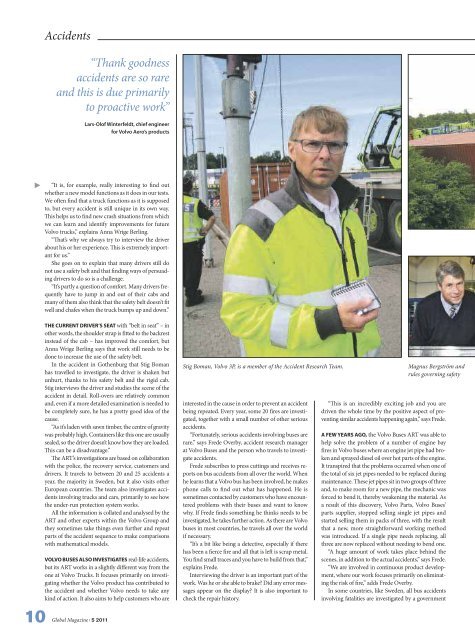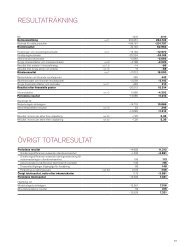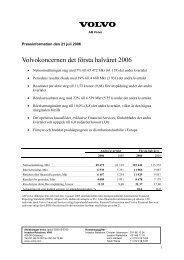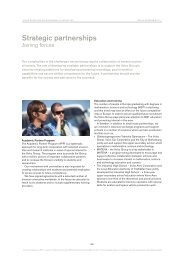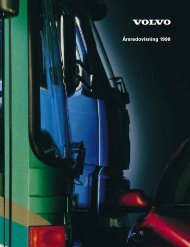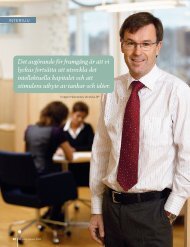After the accident - Volvo
After the accident - Volvo
After the accident - Volvo
- No tags were found...
You also want an ePaper? Increase the reach of your titles
YUMPU automatically turns print PDFs into web optimized ePapers that Google loves.
Accidents“Thank goodness<strong>accident</strong>s are so rareand this is due primarilyto proactive work”Lars-Olof Winterfeldt, chief engineerfor <strong>Volvo</strong> Aero’s products>“It is, for example, really interesting to find outwhe<strong>the</strong>r a new model functions as it does in our tests.We often find that a truck functions as it is supposedto, but every <strong>accident</strong> is still unique in its own way.This helps us to find new crash situations from whichwe can learn and identify improvements for future<strong>Volvo</strong> trucks,” explains Anna Wrige Berling.“That’s why we always try to interview <strong>the</strong> driverabout his or her experience. This is extremely import -ant for us.”She goes on to explain that many drivers still donot use a safety belt and that finding ways of persuadingdrivers to do so is a challenge.“It’s partly a question of comfort. Many drivers frequentlyhave to jump in and out of <strong>the</strong>ir cabs andmany of <strong>the</strong>m also think that <strong>the</strong> safety belt doesn’t fitwell and chafes when <strong>the</strong> truck bumps up and down.”THE CURRENT DRIVER’S SEAT with “belt in seat” – ino<strong>the</strong>r words, <strong>the</strong> shoulder strap is fitted to <strong>the</strong> backrestinstead of <strong>the</strong> cab – has improved <strong>the</strong> comfort, butAnna Wrige Berling says that work still needs to bedone to increase <strong>the</strong> use of <strong>the</strong> safety belt.In <strong>the</strong> <strong>accident</strong> in Go<strong>the</strong>nburg that Stig Bomanhas travelled to investigate, <strong>the</strong> driver is shaken butunhurt, thanks to his safety belt and <strong>the</strong> rigid cab.Stig interviews <strong>the</strong> driver and studies <strong>the</strong> scene of <strong>the</strong><strong>accident</strong> in detail. Roll-overs are relatively commonand, even if a more detailed examination is needed tobe completely sure, he has a pretty good idea of <strong>the</strong>cause.“As it’s laden with sawn timber, <strong>the</strong> centre of gravitywas probably high. Containers like this one are usuallysealed, so <strong>the</strong> driver doesn’t know how <strong>the</strong>y are loaded.This can be a disadvantage.”The ART’s investigations are based on collaborationwith <strong>the</strong> police, <strong>the</strong> recovery service, customers anddrivers. It travels to between 20 and 25 <strong>accident</strong>s ayear, <strong>the</strong> majority in Sweden, but it also visits o<strong>the</strong>rEuropean countries. The team also investigates <strong>accident</strong>sinvolving trucks and cars, primarily to see how<strong>the</strong> under-run protection system works.All <strong>the</strong> information is collated and analysed by <strong>the</strong>ART and o<strong>the</strong>r experts within <strong>the</strong> <strong>Volvo</strong> Group and<strong>the</strong>y sometimes take things even fur<strong>the</strong>r and repeatparts of <strong>the</strong> <strong>accident</strong> sequence to make comparisonswith ma<strong>the</strong>matical models.VOLVO BUSES ALSO INVESTIGATES real-life <strong>accident</strong>s,but its ART works in a slightly different way from <strong>the</strong>one at <strong>Volvo</strong> Trucks. It focuses primarily on investigatingwhe<strong>the</strong>r <strong>the</strong> <strong>Volvo</strong> product has contributed to<strong>the</strong> <strong>accident</strong> and whe<strong>the</strong>r <strong>Volvo</strong> needs to take anykind of action. It also aims to help customers who areStig Boman, <strong>Volvo</strong> 3P, is a member of <strong>the</strong> Accident Research Team.interested in <strong>the</strong> cause in order to prevent an <strong>accident</strong>being repeated. Every year, some 20 fires are investigated,toge<strong>the</strong>r with a small number of o<strong>the</strong>r serious<strong>accident</strong>s.“Fortunately, serious <strong>accident</strong>s involving buses arerare,” says Frede Overby, <strong>accident</strong> research managerat <strong>Volvo</strong> Buses and <strong>the</strong> person who travels to investigate<strong>accident</strong>s.Frede subscribes to press cuttings and receives reportson bus <strong>accident</strong>s from all over <strong>the</strong> world. Whenhe learns that a <strong>Volvo</strong> bus has been involved, he makesphone calls to find out what has happened. He issometimes contacted by customers who have encounteredproblems with <strong>the</strong>ir buses and want to knowwhy. If Frede finds something he thinks needs to beinvestigated, he takes fur<strong>the</strong>r action. As <strong>the</strong>re are <strong>Volvo</strong>buses in most countries, he travels all over <strong>the</strong> worldif necessary.“It’s a bit like being a detective, especially if <strong>the</strong>rehas been a fierce fire and all that is left is scrap metal.You find small traces and you have to build from that,”explains Frede.Interviewing <strong>the</strong> driver is an important part of <strong>the</strong>work. Was he or she able to brake? Did any error messagesappear on <strong>the</strong> display? It is also important tocheck <strong>the</strong> repair history.Magnus Bergström andrules governing safety“This is an incredibly exciting job and you aredriven <strong>the</strong> whole time by <strong>the</strong> positive aspect of preventingsimilar <strong>accident</strong>s happening again,” says Frede.A FEW YEARS AGO, <strong>the</strong> <strong>Volvo</strong> Buses ART was able tohelp solve <strong>the</strong> problem of a number of engine bayfires in <strong>Volvo</strong> buses where an engine jet pipe had brokenand sprayed diesel oil over hot parts of <strong>the</strong> engine.It transpired that <strong>the</strong> problems occurred when one of<strong>the</strong> total of six jet pipes needed to be replaced duringmaintenance. These jet pipes sit in two groups of threeand, to make room for a new pipe, <strong>the</strong> mechanic wasforced to bend it, <strong>the</strong>reby weakening <strong>the</strong> material. Asa result of this discovery, <strong>Volvo</strong> Parts, <strong>Volvo</strong> Buses’parts supplier, stopped selling single jet pipes andstarted selling <strong>the</strong>m in packs of three, with <strong>the</strong> resultthat a new, more straightforward working methodwas introduced. If a single pipe needs replacing, allthree are now replaced without needing to bend one.“A huge amount of work takes place behind <strong>the</strong>scenes, in addition to <strong>the</strong> actual <strong>accident</strong>s,” says Frede.“We are involved in continuous product development,where our work focuses primarily on eliminating<strong>the</strong> risk of fire,” adds Frede Overby.In some countries, like Sweden, all bus <strong>accident</strong>sinvolving fatalities are investigated by a government10 Global Magazine ı 5 2011


